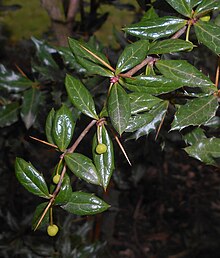| Berberis candidula | |
|---|---|

| |
| Conservation status | |
 Vulnerable (IUCN 3.1) | |
| Scientific classification | |
| Kingdom: | Plantae |
| Clade: | Tracheophytes |
| Clade: | Angiosperms |
| Clade: | Eudicots |
| Order: | Ranunculales |
| Family: | Berberidaceae |
| Genus: | Berberis |
| Species: | B. candidula |
| Binomial name | |
| Berberis candidula Schneid. | |
| Synonyms | |
| |
Berberis candidula is a species of plant in the family Berberidaceae. It is endemic to China, native to the provinces of Hubei and Sichuan. It is commonly known as paleleaf barberry.
Berberis candidula is an evergreen shrub up to 1m tall, with spines along the younger shoots. Leaves are simple, shiny, up to 20 mm long. Flowers are solitary, yellowish-red. Berries are ellipsoid, up to 10 mm long. It grows in thickets and montane roadsides.
References
- China Plant Specialist Group (2004). "Berberis candidula". IUCN Red List of Threatened Species. 2004: e.T46556A11067057. doi:10.2305/IUCN.UK.2004.RLTS.T46556A11067057.en. Retrieved 17 November 2021.
- ^ "Berberis candidula in Flora of China @ efloras.org". www.efloras.org.
- The Plant List
- "Berberis candidula (Paleleaf Barberry) | North Carolina Extension Gardener Plant Toolbox". plants.ces.ncsu.edu. Retrieved 2022-07-31.
- Schneider, Camillo Karl. 1904. Illustriertes Handbuch der Laubholzkunde 1: 303, Berberis hookeri var. candidula
| Taxon identifiers | |
|---|---|
| Berberis candidula |
|
| Berberis hookeri var. candidula | |
This Berberidaceae article is a stub. You can help Misplaced Pages by expanding it. |